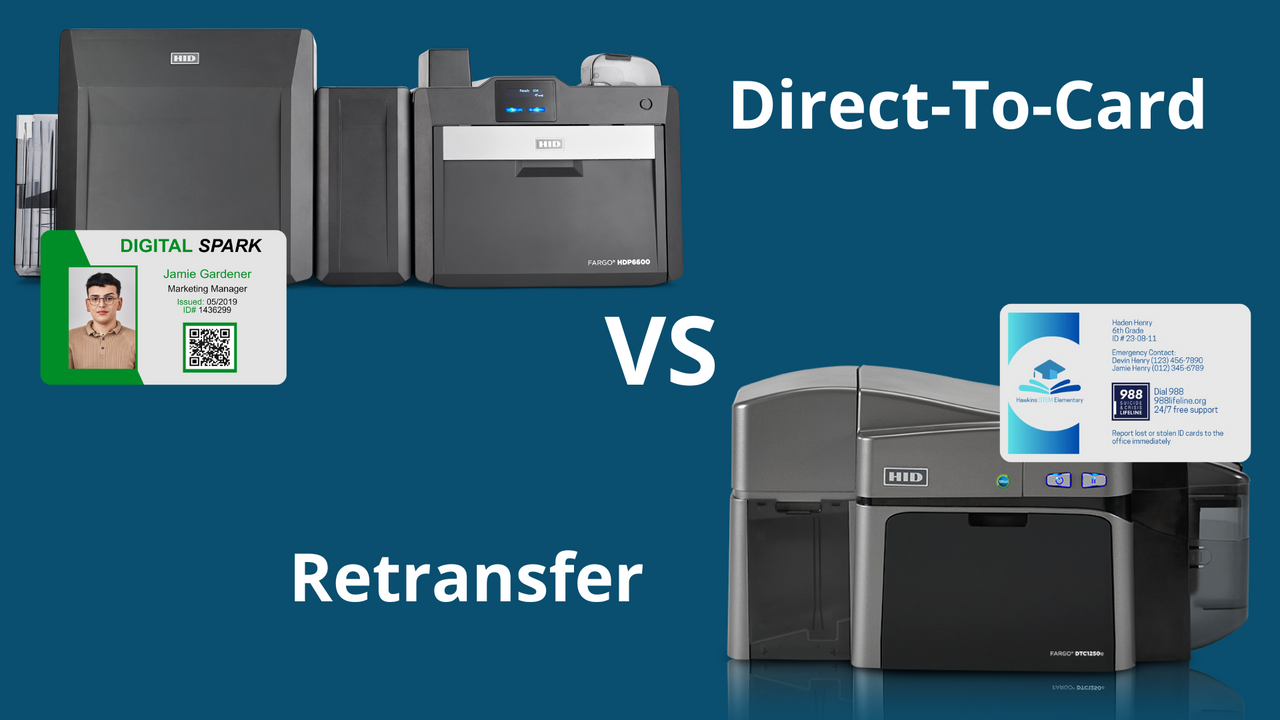ID cards are indispensable for access control, employee identification, and secure transactions. When it comes to producing these cards, choosing the right printer technology is crucial. At AnythingID, we strive to help you make informed decisions by explaining the differences between the two primary types of ID card printers: Direct-to-Card (DTC) and Retransfer. This comprehensive guide will delve into how each technology works, their respective pros and cons, and which applications they are best suited for.
Direct-to-Card (DTC) Printers
How It Works
Direct-to-Card printers, also known as dye-sublimation printers, work by printing directly onto the surface of the card. The print head transfers the ink from a ribbon onto the card, where heat is used to bond the ink to the card surface.
Pros
- Cost-Effective: DTC printers are generally more affordable upfront and have lower operating costs compared to retransfer printers.
- Speed: They can print cards quickly, making them ideal for high-volume environments.
- Compact Size: These printers tend to be smaller and more portable, fitting easily into various office environments.
- Ease of Use: Most DTC printers are user-friendly and require minimal training to operate.
Cons
- Print Quality: The print quality is generally lower than retransfer printers, with potential for visible lines or streaks.
- Edge-to-Edge Printing: DTC printers often leave a small, unprinted border around the edge of the card.
- Card Compatibility: They are less effective on uneven surfaces or cards with embedded chips, as the print head needs a smooth, flat surface.
Best For
- Employee Badges: Fast and cost-effective production of employee identification cards.
- Membership Cards: Ideal for clubs and organizations needing to print large volumes of cards quickly.
- Visitor Passes: Perfect for temporary passes due to the quick print speed and lower costs.
Retransfer Printers
How It Works
Retransfer printers use a two-step process. First, the image is printed onto a clear film. This film is then thermally bonded to the card surface. This indirect printing method allows for high-quality, edge-to-edge printing.
Pros
- Superior Print Quality: Retransfer printers produce high-definition, photo-quality images with vibrant colors and crisp details.
- Edge-to-Edge Printing: These printers can print over the entire surface of the card, including the edges.
- Versatility: They can print on uneven surfaces, such as smart cards and cards with embedded chips.
- Durability: The additional layer of film protects the printed image, making the cards more durable and resistant to wear and tear.
Cons
- Higher Cost: Retransfer printers are more expensive upfront and have higher consumable costs.
- Slower Print Speed: The additional steps in the printing process mean they take longer to produce each card.
- Size and Complexity: These printers are typically larger and more complex to operate, requiring more training and space.
Best For
- High-Security IDs: Government IDs, driver's licenses, and other high-security cards benefit from the superior quality and durability.
- Corporate Badges: For companies that require professional-looking badges with embedded security features.
- Gift Cards: High-quality, durable printing makes retransfer printers ideal for producing gift cards that reflect the brand’s quality.
Making the Right Choice
Choosing between DTC and retransfer printers depends on your specific needs:
- Budget-Conscious and High-Volume Needs: If cost and speed are your primary concerns, a DTC printer is likely the best choice. It is perfect for environments where a large number of cards need to be printed quickly and the highest print quality is not critical.
- Quality and Durability Requirements: If you need high-definition, durable cards that stand up to heavy use and must be printed on varied surfaces, a retransfer printer is worth the investment. This is particularly true for organizations where the ID card serves as a critical part of security infrastructure.
At AnythingID, we understand that every organization has unique requirements. By understanding the strengths and limitations of Direct-to-Card and Retransfer printers, you can make an informed decision that best suits your operational needs and budget. Contact us today for more information or to discuss your specific ID card printing needs.


